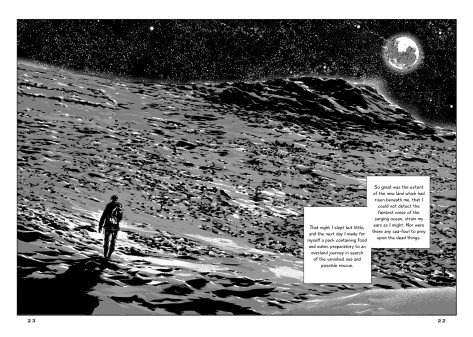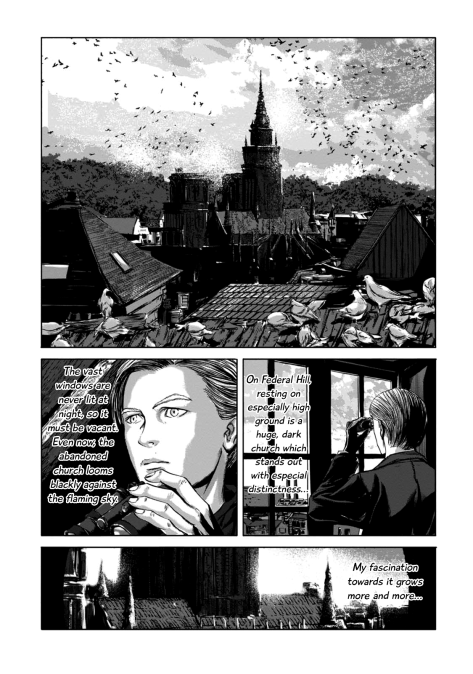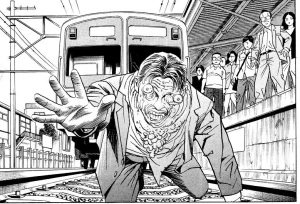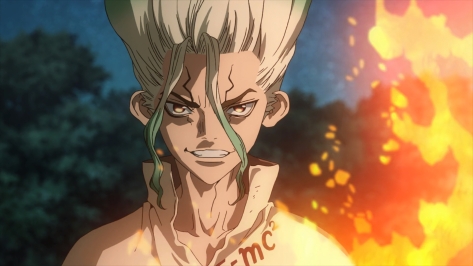The Metamorphosis
Japanese Title: Henshin
Genre: Historical Drama
Length: 5 chapters (1 volume)
This batch of manga has a Western and horror focus, with a little romance to end things on a lighter note. We start with The Metamorphosis, a manga adaptation of Franz Kafka’s famous book of the same name about a man who finds himself transformed into a giant insect one morning. I haven’t read the book, so everything I say applies only to the manga.
The story is largely in flashbacks as the man reflects on his life and the events that led to his isolation as an insect man in his bedroom, shunned by family. As a dutiful son, he takes on all the burdens for his family after his father loses his job. He works hard and soon make decent money travelling from town-to-town selling fabrics. However, his family grows complacent under the ease of their lives now that food is always on their table. The father in particular is lazy. He’s the “back in my day” and “I could show them a thing or two” type to do nothing while reading his newspaper, ignoring the fact that he needs a job. Even the sister, who is the nicest of them, relies on the man for violin tuition money.
This is an interesting story, and while I’m sure the book is better with it’s 200 pages versus the manga’s five short chapters, I quite enjoyed it. Further research after finishing this has revealed to me that there are many interpretations of the story. And the interpretations are varied. I took it to be a harsh reflection of what it means to have others take advantage of you, take you for granted when you give everything and ask nothing in return. The moment you can no longer keep giving is when they no longer see you as useful. You are pathetic, disgusting. An insect.
If you haven’t read The Metamorphosis but want to have a simple understanding of the story, then the manga is an easy gateway. The art is suitably creepy for the insect, though a bit too simple elsewhere.
Overall Quality – Medium
Result: Found it by accident and enjoyed it.
* * * * *
H.P. Lovecraft: Various Stories
Japanese Title: Lovecraft Kessakushuu
Genre: Fantasy Horror
Length: 8 stories of varying length (1-3 volumes each)
H.P. Lovecraft is synonymous with supernatural horror. There is no greater influence on the genre. Cthulhu, monsters of the unknown, mind breaks from forbidden knowledge, and most of the things that nightmares are made of come from his works. It came as a surprise – while browsing at random – to see several of his stories adapted to manga form.
This review covers most of the Lovecraft manga (I couldn’t get my hands on a couple of them) adapted by Gou Tanabe, a Lovecraft connoisseur, including The Haunter in the Dark, The Colour Out of Space, and The Hound and Other Stories.
Another surprise is in how good these manga are. The Metamorphosis is around about the quality I expect of classic adaptations to different formats. This has been quite consistent in comic books, cartoons, and short films that I have seen of classics. Tanabe’s manga do a great job of evoking that air of insanity and general “what the hell is that” tone of Lovecraft’s short stories. The art is among the most realistic that you’ll find in manga, showing much of the story and characters emotions before one even considers the accompanying words. This is proper horror art.
I haven’t read the original versions of these stories (all of my Lovecraft experience come from works influenced by him, mostly video games), but they work perfectly for the uninitiated. At no point do I feel lost, as if there is an expectation that I already know the details of the Lovecraft universe.
These stories, as is most often the case with Lovecraft, involve mysterious supernatural entities, whether monster or ethereal concept, that slowly corrupt the world and its characters. My favourite of these is The Haunter in the Dark. A writer with a passion for the occult takes in interest in a gothic church he can see from his bedroom window. There are local stories about what went on in that abandoned church, yet no one is willing to speak of them. His curiosity gets the better of him and he awakens a creature from the dark. He had better hope the power doesn’t go out…
At the Mountains of Madness is the longest of the adaptations at 25 chapters and one I haven’t had a chance to read. I want to see a story that has a little more time to explore a concept in greater detail.
These manga aren’t perfect, but they are an engaging short reads late at night. Read a few or all of them, it’s up to you how deep you want to delve into madness.
Overall Quality – High
Result: I want to read more Lovecraftian works. These are a good introduction, which I recommend to anyone with a horror interest.
* * * * *
Spring Breeze Snegurochka
Japanese Title: Harukaze no Snegurochka
Genre: Historical Drama
Length: 7 chapters (1 volume)
Continuing with manga based on the West, we look at Spring Breeze Snegurochka. This time we go into Russian 1933, the Soviet Union era, where a woman in a wheelchair and the man that cares for her are in search of something within an old mansion, now controlled by the secret police. They will do anything to find the object.
The most interesting aspect of this piece is the Russian focus, a subject you don’t see much of out of Japan. It taps into many real figures from history, including Rasputin, the Russian royal family, and domestic rebels. Combined with the fictional characters, Spring Breeze makes for decent “what if” alternate history story if you have some familiarity with Russia’s past. If you don’t, the plethora of complex Russian names will go in one ear and out the other. The story is dense with characters, particularly in the latter half when the secrets unravel and people unmask themselves. There is a notable character reveal that means nothing if you don’t know who he is already.
As for the story itself, the history aspect is interesting but not so much for the main two characters. The woman’s rape into Stockholm syndrome into love (?) arc doesn’t work or make sense, not with the page time given. The man is the quiet type with no screen presence.
I don’t recommend this unless you love the subject matter.
Overall Quality – Medium
Result: Interesting to see a manga take on Russian history.
* * * * *
Cambrian
Japanese Title: Cambrian
Genre: Horror Science Fiction
Length: 28 chapters (3 volumes)
To go back to horror for moment, let’s stop at Cambrian. This is a disgusting manga. Literally. It features a biologist who believes he has created the next step of human evolution, splicing humans with marine creatures. He can now transform into an ammonite and rapes women with his tentacles (eating them is also involved) to spread his mutation. He infects a few and they infect more, creating a cult that will take humanity into the “next step.”
Yeah, no thanks. I don’t want to have barnacles covering my skin, even if it means I can rollout like Golem. Patrick maybe a hilarious cartoon character – doesn’t mean I want become a starfish. Looking like the Alien isn’t worth regeneration powers. Especially if my hair now forms into a sea biscuit. The main woman develops spiked nipples and a vajine spike for defence when aroused. I can imagine Cambrian would give nightmares to some people.
There’s a lot of sex (little of it consensual) and sexual violence (not many sample pages I can use for below). However, this isn’t a ℌệ𝔫𝔱ằ𝔦, though I’m sure it’s someone’s fetish. This is more of a sexual horror series, relying on grotesque body horror to engage the audience. This isn’t for me. Even outside of the sex and horror filling most pages, there is little in the way of character development or story. It’s frankly rather boring despite the shock value.
Overall Quality – Low
Result: Wouldn’t have bothered if I knew the result.
* * * * *
Witches
Japanese Title: Majo
Genre: Contemporary Fantasy
Length: 7 chapters (2 volumes)
Enough of the revolting. Why don’t we cheer ourselves up with a manga of magical girls meets Western literature? Dying of the plague is a welcome change.
Witches is an anthology of short stories set in the recent past of our world. Each story chronicles a girl or woman that has to deal with some injustice and she discovers a magical power along the way to help her. The issues are more in the mental realm – dealing with a bigot or some close-minded individual, for instance.
While the stories are from diverse locations and cultures, they do rather feel the same more often than not. Strip away the dressings of the art, the environment, and the personalities – boil down to core plot and character details – and you find much repetition. The dynamic of “good character is wise and smart against bad character, who is dumb and evil” is overused. Witches lacks character subtlety. Read one of these stories and you have read them all.
I want to focus on the art, for a moment. It is simultaneously great and poor. On most pages, in black and white, I do not find the abundance of detail appealing. The art is too messy, the details lost in the mayhem. Rather than admire the art, I find myself looking closer and asking, “What is that supposed to be?” However, there are the occasional colour pages and suddenly it all makes sense. When you have nine different shades of green in a random pattern to create nature, it looks good. Turn it black and white and all we have are scribbles. It recalls that meme of “The teacher’s copy [of the colour image] vs. students’ copy [black and white on the exam sheet],” where you have to label an undecipherable image. I wonder if the artist did the whole original in colour.
It’s probably a matter of taste. I can image people loving the chaos of the visuals as an accompaniment to the chaotic magic. The art is certainly not generic. I would never insult it so.
Overall Quality – Medium
Result: Unusual and different.
* * * * *
Annarasumanara
Korean Title: Annarasumanara
Genre: Mystery Romance
Length: 27 chapters (3 volumes)
Keeping with the theme of magic and adding a dash of romance to the potion, let’s finish on Annarasumanara, a manhwa that blurs the boundaries of magic and reality.
We follow a high school girl going through a rough time, lost in her mind amid the pressures of succeeding at school while feeding her sister. Her dad abandoned them after failing in his career. She finds comfort in visiting a handsome magician at a nearby abandoned amusement park, rumours saying he can perform real magic. (“Annarasumanara” is the magician’s equivalent to abracadabra.)
Annarasumanara is a poignant manhwa that allows the art to do most of the talking to great effect and leaves much open to interpretation. Is any of his magic real? That was just a trick but maybe this was real… How else would you explain it? Similarly, her opinion of the magician is up in the air for much of the story. I like that this isn’t the usual instant infatuation prevalent in manhwa.
There is a subplot between the protagonist and a male classmate, the rival for the top spot in exams. He comes from big money (their house is like a palace on top of a high rise on top of a casino – hilarious metaphor) and ends up paying her to do worse on exams so that he can appear greater. A one-sided relationship develops on his part. He admires her independence, resents her love for the magician. The best part about this guy is his design. He looks like a…worm? Hard to describe – look below. All girls in school call him handsome though, which makes it even better.
I like this one. The writing isn’t spectacular, but the reliance on art over text more than makes up for it.
Overall Quality – High
Result: I recommend it alongside the Lovecraft manga of this batch.
* * * * *
Ao Haru Ride
Japanese Title: Ao Haru Ride
Genre: Romance
Length: 53 chapters (13 volumes)
Wait! One more before we go. Quick one, I promise.
Ao Haru Ride is a shoujo romance about a boy too aloof to share his feelings and girl too shy to take charge. Or is that blurb for another shoujo manga? Most certainly. This is generic shoujo. The art is indistinguishable from its peers and the characters are so inoffensive to the audience’s sensibilities that they don’t stand out in any way.
Most of my manga reading is before sleep (I have a half-finished brick of a fantasy novel by my bed, untouched in months because of manga). Let me put it simply: Ao Haru Ride is great for falling asleep.
After two or so volumes, I can’t be bothered with this. Ao Haru Ride is one of my few dropped manga. I won’t be mentioning any similar shoujo manga in future. It would be repetitive.
Overall Quality – Dropped
Result: I will confuse this for another dozen shoujo manga in future.
(Request reviews here. Find out more about the rating system here.)





























































